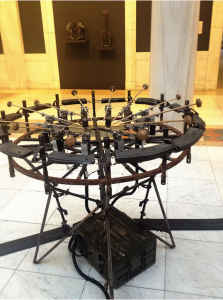Latin American Art: A New Force in the Modern and Contemporary Art Scene
In the last ten years there has been a major shift in the general public’s interest and perception of Latin American Art. The driving force behind this shift is that many significant collectors have been sharing their collections with the world. One such collector is Patricia Phelps de Cisneros, whose collection of modern and contemporary art has traveled the globe. The Colección Patricia Phelps de Cisneros (CPPC) works to support innovation, education, creativity, and research in the field of Latin American Art, with initiatives like their recently-launched bilingual e-books series.

Axel Stein, Senior Vice President and head of the Department of Latin American Art at Sotheby’s, explained that while themes in Latin American art were very politically charged in the first half of the 20th century, during the second part, many artists went to Paris where they were embraced by that art community. There was a fertile exchange of ideas and new directions, especially exploring kinetic and abstract art. This helped to make Latin American artists true players in the world market. “Abstraction and kinetic art are like music, a universal language,” says Stein.
The Museum of Modern Art started collecting Latin American artists in the 1930s, and Diego Rivera was the subject of the museum’s second exhibition in 1931. Even museums that were late to collecting in this area have recently begun actively pursuing Latin American works, such as the Louvre, which launched its initiative with a show of colonial-era Mexican paintings last March. In 2002, the Tate appointed their first Associate Curator of Latin American Art, and expanded their acquisition efforts, showing their continued commitment in 2012 upon hiring Colombian curator José Roca. Stein said “museums started doing their job,” referring to the groundbreaking 2004 exhibition “Inverted Utopias: Avant-Garde Art Latin America” at Museum of Fine Arts, Houston as the “fireworks” signaling a shift in the public view of this genre.
The process of collecting Latin American Art is exciting because collectors discover artists that have been overlooked on every level and the material is fresh. Swiss philanthropist Ruth Schmidheiny started collecting in this domain 15 years ago, and in 2013 opened Casa Daros in Rio de Janeiro. Curator Hans-Michael Herzoy explained in a press conference “In Europe at that time there was zero interest because people knew nothing about Latin American Art.”

This is changing, with many Latin American artists rapidly ascending to the heights of the international art scene. Contemporary Mexican artist Pedro Reyes is featured in the 2013 Carnegie International in Pittsburgh. Ninety-eight year-old Cuban-born artist Carmen Herrera was “discovered” just in the last five years. Her gallery in London is the renowned Lisson Gallery, which also represents Ai Weiwei, Anish Kapoor and Sol LeWitt. In Mexico City, Eugenio López’s Colección Jumex will find a new home at the Museo Jumex, a private museum that will house one of the largest collection of Latin American art. The David Chipperfield-designed museum will open its doors in mid-November of 2013.
Collectors are opening their own museums and foundations highlighting Latin American artists. These artists are now part of the “global art network,” producing exciting works and are a force to be reckoned with.
Visit the seventh-annual PINTA New York fair opening to the public November 15th.
Images from artsy.net.
About Art Privée

Our mission is to enable art enthusiasts to easily locate and uncover essential information on contemporary art collections and exhibitions worldwide.
Linda Fischbach - Founder